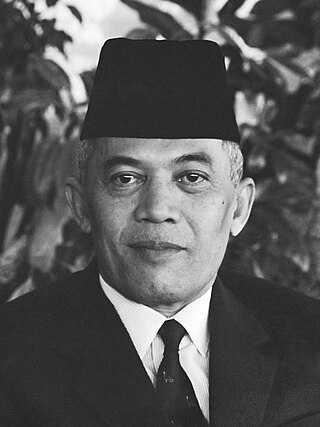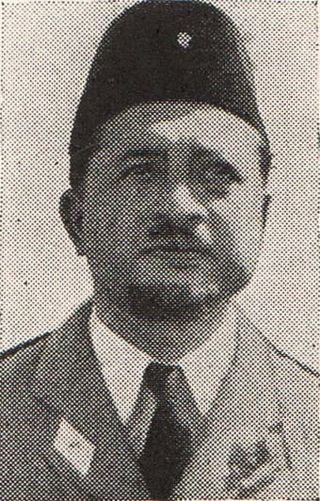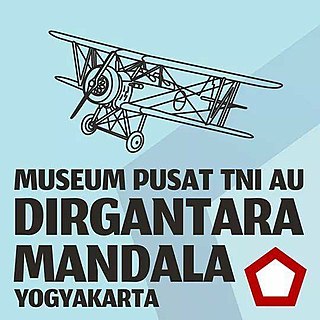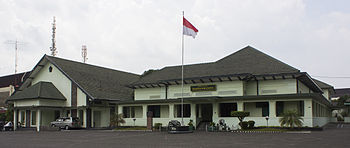
The Indonesian National Armed Forces are the military forces of the Republic of Indonesia. It consists of the Army (TNI-AD), Navy (TNI-AL), and Air Force (TNI-AU). The President of Indonesia is the Supreme Commander of the Armed Forces. As of 2023, it comprises approximately 400,000 military personnel including the Indonesian Marine Corps, which is a branch of the Navy.

Abdul Haris Nasution was a high-ranking Indonesian general and politician. He served in the military during the Indonesian National Revolution and he remained in the military during the subsequent turmoil of the Parliamentary democracy and Guided Democracy. Following the fall of President Sukarno from power, he became the Speaker of the People's Consultative Assembly under President Suharto. Born into a Batak Muslim family, in the village of Hutapungkut, Dutch East Indies, he studied teaching and enrolled at a military academy in Bandung.

The Indonesian Army is the land branch of the Indonesian National Armed Forces. It has an estimated strength of 300,400 active personnel. The history of the Indonesian Army has its roots in 1945 when the Tentara Keamanan Rakyat (TKR) "People's Security Army" first emerged as a paramilitary and police corps.

Purwokerto is a large but non-autonomous town on the island of Java, Indonesia. It is the coordinating centre of local government and the largest city in southwestern Central Java. Currently, Purwokerto is the capital of Banyumas Regency, Central Java province. The population of the four districts which comprise the town at the 2010 census was 233,951 and 229,271 at the 2020 census; the official estimate as of mid-2023 was 233,865. The City is considered to be the most comfortable city in Indonesia, as it is the favourite place for pensioners to live after they have finished working.

Sleman Regency is an Indonesian regency on the island of Java. It is located in the north of the Yogyakarta Special Administrative Region, Indonesia, and has an area of 574.82 square kilometres (221.94 sq mi), with a population of 1,093,110 at the 2010 Census and 1,125,804 at the 2020 Census; the official estimate as at mid 2023 was 1,157,292 - comprising 573,760 males and 583,540 females. Its capital is the town of Sleman. The current regent is Kustini Sri Purnomo.

Operation Kraai was a Dutch military offensive against the de facto Republic of Indonesia in December 1948, following the failure of negotiations. With the advantage of surprise, the Dutch managed to capture the Indonesian Republic's temporary capital, Yogyakarta, and seized Indonesian leaders such as de facto Republican President Sukarno. This apparent military success was, however, followed by guerrilla warfare, while the violation of the Renville Agreement ceasefire diplomatically isolated the Dutch. This led to the Dutch–Indonesian Round Table Conference and recognition of the United States of Indonesia.

Purworejo is a regency in the southern part of Central Java province in Indonesia. It covers an area of 1,081.45 km2 and had a population of 695,427 at the 2010 Census and 769,880 at the 2020 Census; the official estimate as at mid 2023 was 788,265. Its capital is the town of Purworejo.

General Gatot Soebroto was an Indonesian general who began his military career with the Royal Dutch East Indies Army (KNIL) and rose to be deputy Army chief-of-staff.

The First Hatta Cabinet was Indonesia's seventh cabinet. It was formed by Vice President Mohammad Hatta, who was instructed to do so by President Sukarno on 23 January 1948, the same day the previous cabinet was declared dissolved. Following the second Dutch military aggression, when the republican capital of Yogyakarta was seized and most of the cabinet arrested, much of the cabinet was captured and sent into exile, although it was not formally disbanded. After the political leadership returned effective 13 July 1949 the cabinet continued its mandate until it was reshuffled on 4 August.

General Raden Oerip Soemohardjo was an Indonesian general, the first chief of general staff of the Indonesian National Armed Forces, and acting Commander of the Indonesian National Armed Forces. He received several awards from the Indonesian government, including the title National Hero of Indonesia in 1964.

Kusumanegara Heroes' Cemetery is a cemetery located in Yogyakarta, Indonesia. It is the final resting place of five National Heroes of Indonesia.

Sudirman was an Indonesian military officer and revolutionary during the Indonesian National Revolution and the first commander of the Indonesian National Armed Forces.

The Satriamandala Museum is the main museum for the Indonesian Armed Forces. Opened on 5 October 1972, it is located on 5.6 hectares of land in South Jakarta and holds numerous artifacts, weapons, and vehicles.
Sasana Wiratama, also known as Museum Monumen Pangeran Diponegoro is a museum complex in Yogyakarta, Indonesia. The complex consists of a museum and a monument which commemorates the struggle of Prince Diponegoro, an 18th-century Javanese prince and a National Hero.
Gatot Soebroto Central Army Hospital is a military hospital in Jakarta, Indonesia. The name of the hospital is derived from Gatot Soebroto, a National Hero of Indonesia. Established in 1819, the hospital is the main hospital for the Indonesian Army. The hospital also provides limited services for civilians.

The Semarang offensive is composite of the Battle of Ambarawa, Magelang offensive, Battle of Ungaran or Ungaran offensive, and Semarang offensive proper. This major battle took place between the recently created Indonesian Army and the British Army with the Dutch forces that occurred between 20 October 1945 and 2 March 1946 in Semarang city, Semarang Regency, and Magelang Regency in Central Java, Indonesia. Perhaps the most successful Indonesian offensive of the Indonesian Revolution, this offensive tightened British and Dutch control from the Magelang and Semarang metropolitan areas to only Semarang city. In modern times, 15 December is celebrated as the Indonesian National Infantry Day.

The siege of Surakarta was a military campaign during the Indonesian National Revolution. The Indonesian Republican forces (TNI) briefly infiltrated the city of Surakarta before being repulsed by Dutch special forces (RST). Despite the defeat, the battle, together with an earlier attack on Yogyakarta, provided a morale boost for the Indonesians.

Dirgantara Mandala Museum, officially known as the Central Museum of the Indonesian Air Force "Dirgantara Mandala", is a museum of the history of the Indonesian Air Force. Dirgantara Mandala Museum also has a comprehensive collection of aviation in Indonesia, from early biplanes to modern jet engines. It is located in the complex of Adisutjipto International Airport in Bantul Regency, Yogyakarta, Indonesia.
The following is an order of battle of the Indonesian National Armed Forces as of 8 January 1946, after the then People's Security Armed Forces was transformed into the People's Safety Armed Forces by Presidential Resolution #2/1946.

The People's Security Army or commonly abbreviated as TKR is the name of the first military force formed by the Indonesian Government, after the Proclamation of Indonesian Independence. TKR was formed on October 5, 1945, based on an announcement issued by the Government of the Republic of Indonesia. TKR was formed as a result of improving the function of the previously existing People's Security Agency (BKR) and its core army was taken from the former KNIL & PETA.




















